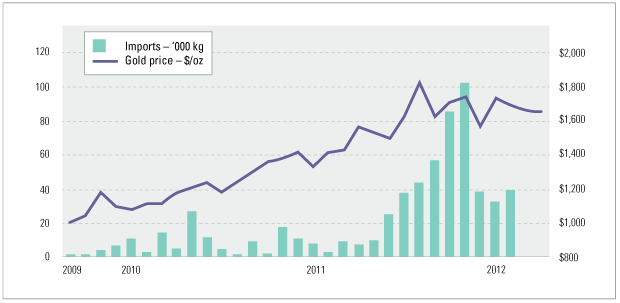Perhaps it's Euro-crisis fatigue, or maybe just plain denial, but the equity markets appear unwilling to acknowledge how close we are now to yet another round of Eurozone upheaval. Spain's economy is almost five times that of Greece. Spain also has over four times the amount of externally-held nominal debt outstanding.16 If the bond vigilantes choose to punish the Spanish 10-year bond (currently trading precariously close to a 6% yield), we could soon be back where we were this past September, only with a problem four times as large.
The rest of Europe isn't looking so hot either. Italy's bond market is in a similar situation to that of Spain, with the Italian 10-year bond trading perilously close to the 6%-yield threshold. Recent data showed the European Purchasing Managers Index (PMI) falling to 47.4 in March, well below the 50 mark which signals growth in industrial activity.17 German PMI recently confirmed this move with its April release of 46.3, down from 48.4 in March, representing the fastest rate of contraction since July 2009.18 These declines in economic activity, combined with the austerity measures most Euro countries are currently attempting to impose, almost guarantee more printed money will be pumped into the European bond markets before the year is over. It's simply a matter of time.
As expected, the powers that be are busy parading around in preparation for the next round of Eurozone panic, with the IMF using the renewed concerns as an opportunity to re-establish its relevance as a firewall provider. The IMF most recently secured $430 billion worth of new "pledges" from various G20 member countries to increase its potential lending capacity to $700 billion in the event of further problems in the Eurozone.19 Not unsurprisingly, the BRICS countries have expressed irritation at the disproportionate voting power held by Western powers within the IMF at the expense of themselves and the other developing nations. In prepared remarks at an IMF press conference, Brazil's finance minister criticized the skewed quotas that dictate voting power, stating that, "The calculated quota share of Luxembourg is larger than the one of Argentina or South Africa… The quota share of Belgium is larger than that of Indonesia and roughly three times that of Nigeria. And the quota of Spain, amazing as it may seem, is larger than the sum total of the quotas of all 44 sub-Saharan African countries."20 This unbalance used to make sense when the IMF was designed to help fund ailing third world and developing countries through economic crisis. But that is clearly no longer the IMF's main purpose.
It must be difficult for the BRICS countries today. On one hand, they continue to jockey for respect among the Western powers, insisting on participating in quasi-European bailout funds like the IMF. On the other hand, they are also clearly aware of the Western nations' continuing efforts to surreptitiously devalue their domestic currencies, and the pernicious effect that has had on them as exporters and as lenders of capital. In that vein, it was interesting to note that during the latest BRICS Summit held this past March in New Delhi, the main topic of discussion centered on the creation of the group's first official institution, a so-called "BRICS Bank" that would fund development projects and infrastructure in developing nations. Although not openly discussed, reports suggest what they were really talking about was creating a type of BRICS central bank - an institution that could facilitate their ability to "do more business with each other in their local currencies, to help insulate from U.S. dollar fluctuations…"21 Given the incredible scale of western central bank intervention over the past six months, the BRICS' increasing frustration with their printing efforts should be a given by now. The real question is what they're doing about it, and what assets they're accumulating to protect themselves from the inevitable, which brings us to gold.
Although the paper gold price has been range-bound over the past month, the physical gold market has been undergoing staggering change. Earlier this month it was revealed that Hong Kong gold imports into China totaled nearly 40 tonnes in the month of February, representing a 13-fold increase over the same month last year (see Figure 2).22 40 tonnes annualized equates to 480 tonnes per year - a massive number in a market that only produced 2,810 tonnes of mine supply in 2011.23
FIGURE 2: CHINA'S GOLD IMPORTS FROM HONG KONG

Source: Hong Kong Census and Statistic Dept, Reuters
Reuters graphic/Catherine Trevethan, Rujun Shen 11/04/12
If there's one thing we now know for certain, it's the fact that the market has completely missed the importance of the demand-side changes currently taking place in the physical gold market. China has now imported 436 tonnes of gold through Hong Kong over the past eight months.24 This compares to imports of a mere 57 tonnes over the same eight month-period a year earlier (July 2010 - February 2011). The net new demand implied by this increase is 379 tonnes, which when annualized equates to 568 tonnes of new demand in a market that supplies 2,810 tonnes per year in mine production. These are astounding numbers. Recent IMF data also shows that at least 12 countries increased their physical gold reserves by 58 tonnes in the month of March, with Mexico, Turkey, Russia and Kazakhstan making sizeable purchases.25 58 tonnes annualized equates to 696 tonnes of demand per year. We know that central banks bought 439.7 tonnes of gold in 2011, and if the pace of recent central bank purchases continues, it will equate to another 256 tonnes of net new change in the physical gold market.












